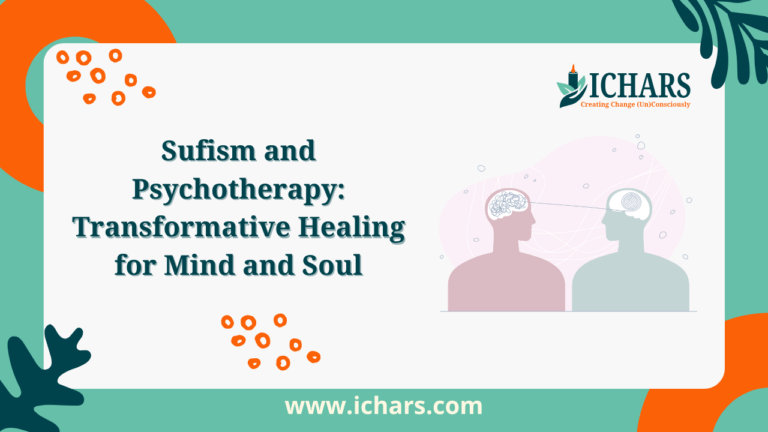Introduction: The Power of Sufism in Emotional Healing
In the pursuit of emotional healing and self-realization, Sufism—an ancient mystical tradition within Islam—offers an unparalleled depth of wisdom that transcends conventional therapeutic approaches.
Its teachings, centered around love, surrender, unity, and divine connection, speak to the heart of human suffering, guiding individuals toward an enlightened state of emotional wellbeing and spiritual fulfillment.
Integrating Sufi principles into Cognitive Hypnotic Psychotherapy (CHP) creates a transformative therapeutic model that not only addresses the mental and emotional layers of a client’s experience but also engages their spiritual essence.
CHP is already a comprehensive approach to psychotherapy, weaving together cognitive, behavioral, humanistic, and subconscious techniques to facilitate change. However, when paired with Sufi wisdom, it becomes a powerful tool for holistic transformation, helping clients navigate the depths of their emotions and reconnect with their higher selves.
This article explores how the rich tapestry of Sufism can be integrated into CHP, enhancing emotional healing and facilitating profound personal growth.
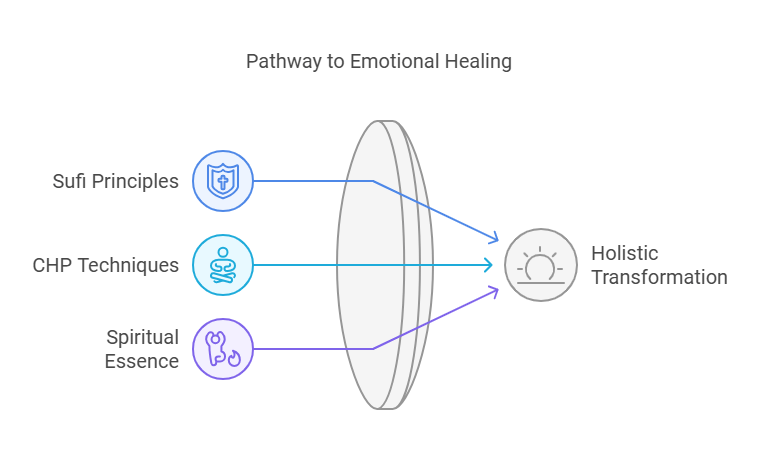
The Core Teachings of Sufism and Their Relevance to Psychotherapy
To understand the impact of Sufism on emotional wellbeing and psychotherapy, it is essential to delve into its foundational teachings. These principles, deeply rooted in spiritual practice and mysticism, offer profound insights into the human condition and provide a roadmap for emotional and spiritual healing.
Tawhid: The Unity of All Existence
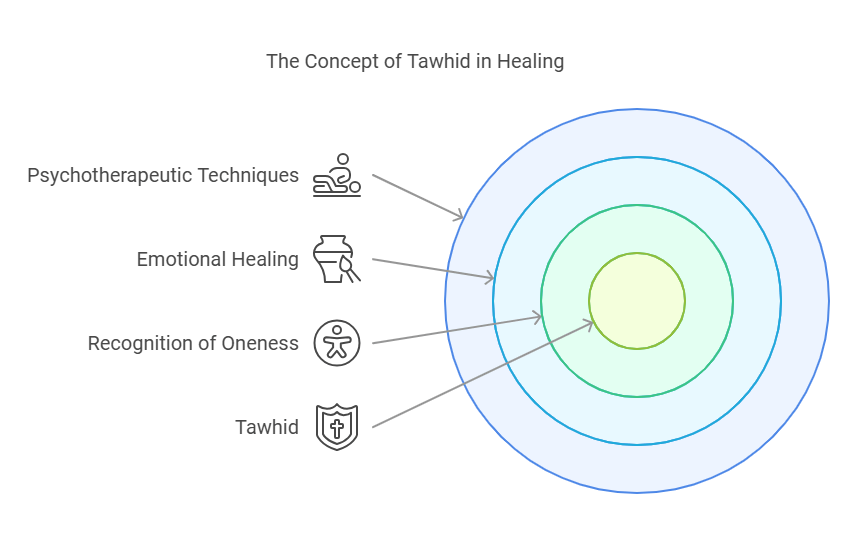
At the heart of Sufi mysticism is Tawhid, the belief in the absolute oneness of God and the interconnectedness of all creation. In Sufi thought, every aspect of existence, from the physical to the metaphysical, is unified in a divine cosmic order.
Human beings, in their essence, are reflections of this divine unity, and it is through recognizing and embodying this oneness that true healing can occur.
In the context of psychotherapy, this concept is transformative. For individuals grappling with feelings of isolation, fragmentation, or a sense of being disconnected from themselves or others, Tawhid offers a powerful antidote.
By helping clients recognize their inherent interconnectedness with the universe, therapists can assist them in overcoming feelings of separateness and alienation.
Techniques such as guided imagery, hypnosis, and mindfulness in CHP can facilitate this experience of oneness, creating a space where clients see their emotional struggles as part of a larger whole.
This shift in perception allows for deeper healing, as clients no longer view their challenges as isolated or insurmountable but as part of a grand, divine narrative.
Ishq: Divine Love and Compassion as the Source of Healing
Ishq, or divine love, is the Sufi concept that describes the passionate longing for union with the Divine. This love is not romantic but an all-encompassing, unconditional love that transcends the self and dissolves the ego.
In the Sufi path, Ishq is both the journey and the destination—the love for the Divine that drives the soul toward its true nature. This love purifies the heart, opens the soul, and creates a deep sense of peace and fulfillment.
In therapy, the principle of Ishq can be reframed as unconditional self-love and compassion. For many clients, especially those struggling with self-criticism, low self-esteem, or emotional wounds, the absence of self-love is a significant barrier to healing.
By introducing clients to the transformative power of divine love, therapists can guide them to cultivate a loving, nurturing relationship with themselves. Guided visualizations, affirmations, and self-hypnosis techniques can be used to help clients embody this love, allowing them to release negative self-talk and internalized criticism.
As clients experience divine love in their inner world, they begin to heal emotionally, opening themselves up to deeper states of compassion and understanding toward others.
The Heart (Qalb): The Center of Emotional and Spiritual Wisdom
For Sufis, the Qalb, or heart, is not simply an organ but the seat of spiritual awareness and emotional intelligence. The heart is where divine wisdom resides, and it is through purifying the heart that an individual can access higher consciousness and experience spiritual enlightenment.
Sufis believe that the heart is the inner guide that can lead one toward healing, self-realization, and divine union.
In psychotherapy, many emotional blockages and past traumas are stored in the heart area, manifesting as physical tension, emotional numbness, or unresolved pain.
By incorporating the Sufi focus on the heart, therapists can guide clients to connect with their deepest emotional truths. In CHP, therapists can use heart-centered techniques such as breathwork, guided meditations, and hypnosis to facilitate emotional release and promote heart healing.
As clients open their hearts, they experience a greater flow of love, compassion, and emotional clarity, leading to profound breakthroughs in their healing journey.
Tawba: Surrendering the Ego and Embracing Emotional Freedom
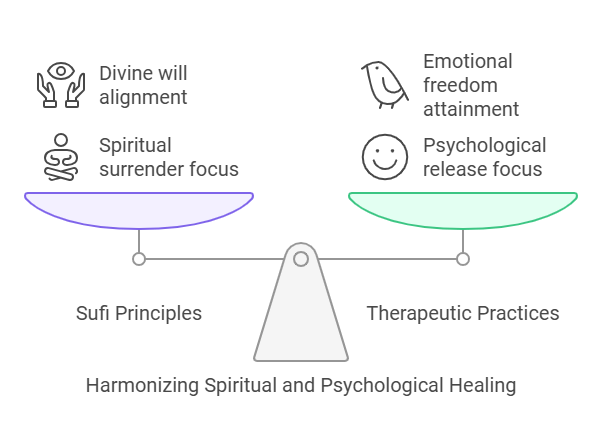
Tawba, the act of repentance or returning to God, refers to the process of surrendering the ego and letting go of attachments that keep an individual from their true self.
In Sufi thought, the ego is seen as the source of illusion and suffering, and true healing can only occur when the ego is dissolved, and the individual surrenders their will to the divine.
In therapy, the process of letting go of ego attachments is central to emotional healing. Many clients enter therapy with deeply ingrained patterns of control, resistance, or rigid thinking. These patterns often stem from unresolved emotional wounds or limiting beliefs.
By incorporating the principle of Tawba, therapists can guide clients to release their attachment to these patterns, allowing them to experience greater emotional freedom and inner peace.
Techniques such as reframing, guided imagery, and ego-surrender exercises can help clients let go of the need to control or resist their emotional experiences, fostering a sense of trust and acceptance.
Suluk: The Spiritual Journey of Growth and Purification
Suluk is the Sufi term for the spiritual journey of growth, purification, and self-discovery. It is the process of striving toward spiritual enlightenment, shedding the layers of the ego, and aligning with divine truth.
The path of Suluk is not linear; it is a journey that requires patience, dedication, and self-reflection. Each stage of the journey brings new insights, challenges, and opportunities for growth.
In therapy, Suluk can be understood as the ongoing process of healing and self-actualization. Clients often come to therapy seeking relief from emotional pain, but the deeper healing process involves spiritual awakening and personal transformation.
By framing therapy as a journey of Suluk, therapists can help clients view their emotional struggles as part of their growth and evolution. This perspective fosters resilience, encourages self-compassion, and helps clients stay engaged in the therapeutic process, knowing that each step is leading them closer to wholeness.
Integrating Sufism into Cognitive Hypnotic Psychotherapy
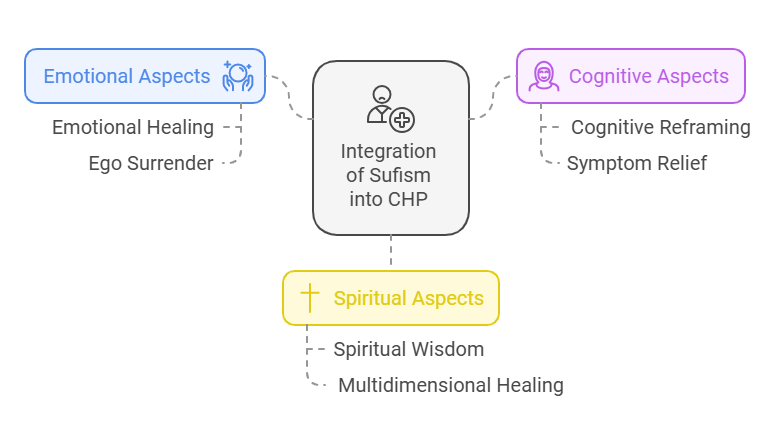
Integrating the teachings of Sufism into Cognitive Hypnotic Psychotherapy (CHP) is not simply about adding a spiritual dimension to an existing therapeutic practice.
It is about creating a comprehensive, multidimensional approach to healing that honors the emotional, cognitive, and spiritual aspects of a person’s being. By weaving Sufi principles into the fabric of CHP, therapists can facilitate deep, lasting change that goes beyond surface-level symptom relief.
CHP Techniques for Integrating Sufi teachings into therapy
Below are several practical ways in which Sufi teachings can be integrated into CHP to enhance the therapeutic experience:
Heart-Centered Hypnotherapy and Meditation
Heart-centered hypnotherapy involves guiding clients to focus their attention on the heart area during hypnosis, facilitating emotional release and spiritual insight. This technique can help clients access deep emotional layers and promote self-compassion.
Incorporating Sufi-inspired meditation practices, such as Dhikr (remembrance of God), can also help clients cultivate a sense of inner peace and spiritual connection. By focusing on the heart and practicing mindfulness, clients can release emotional blocks and experience profound healing.
Divine Love Affirmations and Reprogramming
To integrate the concept of Ishq (divine love) into therapy, therapists can guide clients in using affirmations that promote self-love, acceptance, and compassion.
These affirmations can be combined with self-hypnosis techniques to reprogram the subconscious mind, replacing negative self-talk with nurturing, loving thoughts. Over time, this practice can shift the client’s internal dialogue and foster a deeper sense of emotional wellbeing and self-acceptance.
Ego Surrender and Emotional Reframing
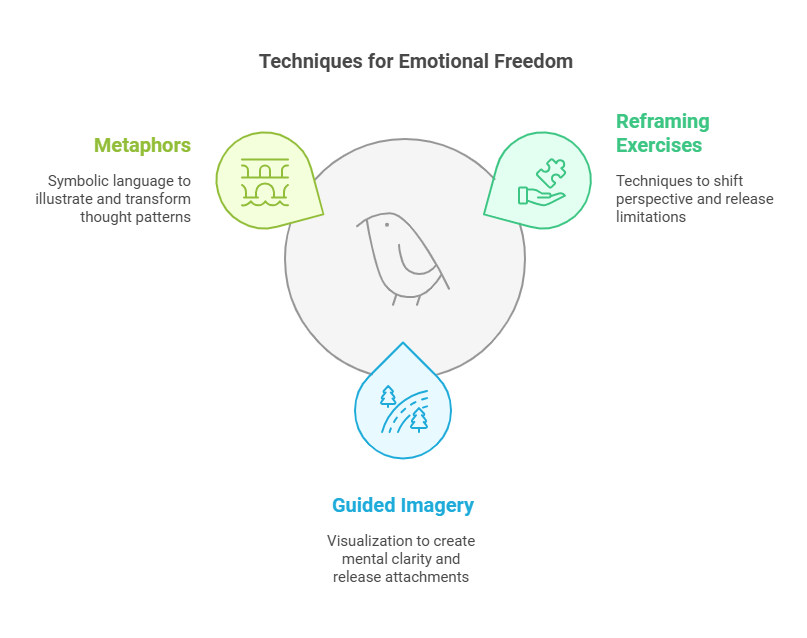
Therapists can incorporate the principle of Tawba (ego surrender) by guiding clients through reframing exercises that encourage the release of limiting beliefs, emotional attachments, and rigid thought patterns.
Techniques such as guided imagery, metaphors, and cognitive reframing can help clients let go of these egoic structures, allowing for greater emotional freedom and resilience. By surrendering the need to control or resist their experiences, clients can cultivate a more open, receptive attitude toward life.
Viewing Therapy as a Journey of Suluk
The principle of Suluk (spiritual journey) can be applied to therapy by helping clients understand that their healing process is an ongoing journey of growth, purification, and self-discovery.
Rather than focusing solely on symptom relief, therapists can encourage clients to see each therapeutic session as a step along their path of personal transformation. This perspective instills a sense of purpose, patience, and perseverance, allowing clients to embrace the process of healing as a lifelong journey.
The Impact and Benefits of Integrating Sufism and CHP
Integrating Sufi principles into Cognitive Hypnotic Psychotherapy offers several profound benefits, both for clients and therapists alike:
- Holistic Healing: By addressing the emotional, cognitive, and spiritual aspects of the client’s experience, the integration of Sufism into CHP facilitates a deeper, more comprehensive healing process.
- Enhanced Self-Awareness and Personal Growth: Clients gain a profound understanding of their emotional patterns, thought processes, and spiritual needs, fostering greater self-awareness and personal growth.
- Emotional Resilience and Freedom: Through practices of self-love, ego release, and heart-centered healing, clients build emotional resilience and experience greater emotional freedom.
- Spiritual Fulfillment and Alignment: Clients who integrate Sufi teachings into their therapeutic journey experience a deeper connection to their higher selves, fostering a sense of spiritual fulfillment and alignment.
- A Continuous Path of Transformation: By framing therapy as a journey of Suluk, clients view their emotional and spiritual growth as an ongoing process, providing a sense of hope, purpose, and empowerment.
Case Study: A Transformational Journey with Sufism and CHP
Background:
Ahmed, a 42-year-old man, sought therapy to address deep-rooted feelings of anger, guilt, and unresolved grief stemming from his past.
Despite his outward success, he struggled with self-worth issues and felt disconnected from his own emotions. Ahmed was skeptical about the role of spirituality in therapy but was open to exploring new approaches.
Therapeutic Process:
The therapist introduced Ahmed to the Sufi principle of Tawhid (oneness), helping him recognize his inherent connection to the universe and his divine nature. Guided meditations focused on the heart area facilitated emotional release and opened Ahmed to deeper feelings of love and compassion.
Over time, the therapist incorporated the concept of Ishq (divine love), guiding Ahmed to practice self-love and acceptance through affirmations and self-hypnosis. These practices helped Ahmed confront his emotional wounds and shift his perspective on life.
Outcomes:
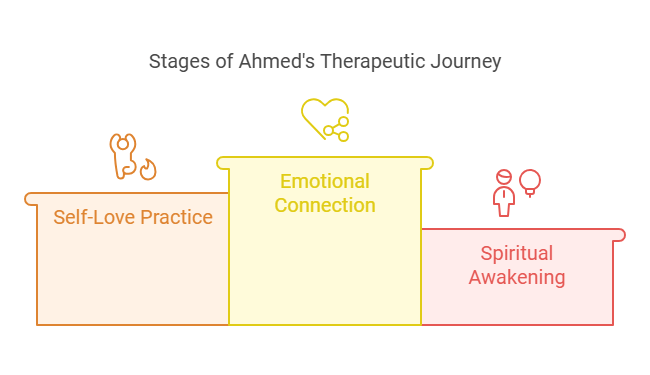
As therapy progressed, Ahmed experienced profound emotional healing. He no longer felt weighed down by anger or guilt; instead, he embraced his journey of self-discovery and spiritual awakening.
Ahmed reported feeling more aligned with his true self and experienced greater peace, compassion, and emotional resilience. He viewed his healing process as an ongoing journey, with each session bringing him closer to his authentic, spiritual self.
Conclusion: The Transformative Fusion of Sufism and CHP
The integration of Sufi principles into Cognitive Hypnotic Psychotherapy creates a powerful, transformative therapeutic model that addresses the mind, body, and spirit.
By guiding clients through the healing process with the wisdom of Sufism, therapists can help them reconnect with their higher selves, overcome emotional blocks, and experience deep spiritual fulfillment.
This holistic approach not only heals the emotional wounds of the past but also empowers clients to live more authentically, embracing the ongoing journey of growth and transformation.
Through the fusion of Sufism and CHP, clients embark on a profound path of self-realization and spiritual awakening, cultivating emotional freedom, resilience, and inner peace.
In this way, therapy becomes not just a means of alleviating suffering but a sacred journey of self-discovery and divine connection.
